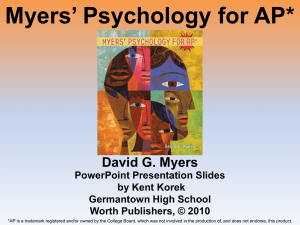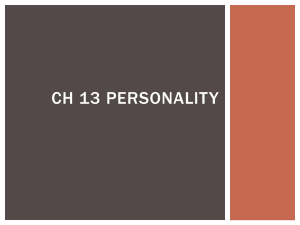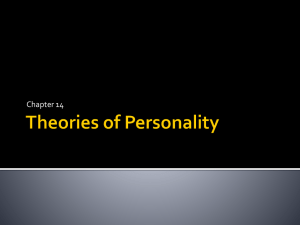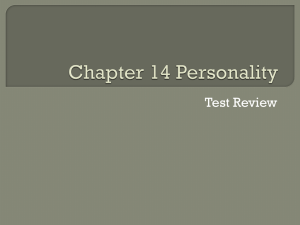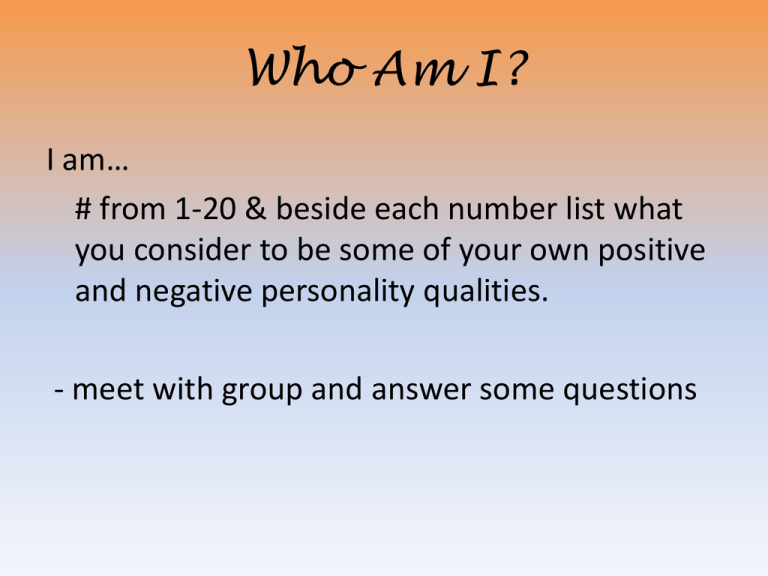
Who Am I?
I am…
# from 1-20 & beside each number list what
you consider to be some of your own positive
and negative personality qualities.
- meet with group and answer some questions
• Introduce yourself to other members of the
group and tell them about your personality.
• After everyone has spoken…
– Identify the four descriptive terms used most
frequently
– Why does the group think these specific terms
were used to describe personality?
– Identify any of the self-descriptive terms that do
not really qualify as personality characteristics.
– What makes a personal quality part of your
personality?
Unit 10:
Personality
Introduction
• Personality
– An individual’s characteristic pattern of
thinking, feeling & acting.
behavioral
consistency
– Enduring
behavior
patterns that make us
unique
Field of Personality Psychology
Do humans have
free will?
Psychoanalytic Perspective
Exploring the Unconscious
• Parts of the mind
– Conscious
– Preconscious
– Unconscious
• a reservoir of mostly unacceptable thoughts, wishes,
feelings, & memories. According to contemporary
psychologists, information processing of which we are
unaware
• Free association
– exploring the unconscious in which the person relaxes and says
whatever comes to mind, no matter how trivial or embarrassing
• Psychoanalysis
Psychoanalysis
• Freud’s theory of personality that attributes
thoughts and actions to unconscious
motives and conflicts
• the techniques used in treating
psychological disorders by seeking to
expose and interpret unconscious tensions
Exploring the Unconscious
Personality Structure
• Personality structure
–Id
• Pleasure
principle
–Ego
• Reality
principle
–Superego
• conscience
Exploring the Unconscious
Personality Development
• Psychosexual stages
–Oral
–Anal
–Phallic
–Latency
–Genital
Orange
Aardvarks
Push
Lazy
Goats
Exploring the Unconscious
Psychosexual Stages
Exploring the Unconscious
Psychosexual Stages
Erogenous Zones
fixated: seeking others’ approval
Exploring the Unconscious
Psychosexual Stages
control
Exploring the Unconscious
Psychosexual Stages
Oedipus
Complex
gender identity
conflict resolution
Exploring the Unconscious
Psychosexual Stages
Exploring the Unconscious
Personality Development
•
•
•
•
•
Erogenous zones
Oedipus complex
Electra complex
Identification
Fixation
Personality
Exploring the Unconscious
Psychosexual Stages
Exploring the Unconscious
Defense Mechanisms
• Defense mechanisms
– Repression
• banishes anxiety- arousing thoughts, feelings,
and memories from consciousness.
– Regression
• retreats to a more infantile psychosexual stage,
where some psychic energy remains fixated.
– Reaction formation
• Reduces anxiety by taking up opposite feeling
– Projection
• Putting our own unacceptable qualities onto
someone else (false consensus effect)
– Rationalization
• Self-justifying explanations
– Displacement
• Taking out our unacceptable feelings on less
threatening objects or persons
– Sublimation
• Channeling unacceptable impulses into socially
acceptable forms
– Denial
• Refuse to believe painful realities
Children who release unexpressed anger toward
their parents by kicking the family pet illustrate the
defense mechanism of
Displacement
Mrs. Smith, who is White and unconsciously in favor
of racial segregation, tells her friends that most
Blacks prefer to live in residential neighborhoods
inhabited predominantly by Blacks. According to
psychoanalytic theory, Mrs. Smith best illustrates
Projection
A religious leader who attempts to overcome his
hidden doubts with intense expressions of spiritual
certainty illustrates most clearly the defense
mechanism of
Reaction Formation
After an argument with your girlfriend, you go
to the gym and lift weights to burn off your
pent-up energy. Your action best illustrates
which defense mechanism?
Sublimation
After an argument with your little brother, you
slam the door to your bedroom instead of
hitting him. Your action best illustrates which
defense mechanism?
Displacement
Defense Mechanisms
1.
2.
3.
4.
5.
6.
7.
8.
9.
E
A
C
G
F
D
E
F
B
10. A
19. D
27. G
11. C
20. B
28. F
12. E
21. E
29. C
30. B
31. D
32. G
33. B
34. E
35. A
13. G
14. D
15. B
16. F
22.A
23. F
24.G
17. A
25. D
18. C
26. C
Objective 3:
The Neo-Freudian Theorists
• Neo-Freudians
Jung
collective unconscious – common set of
ideas, feelings, images
• Archetypes
Adler
– Striving for superiority (self improvement)
• Superiority Complex
• Inferiority complex
• Social Interest – innate potential to cooperate w/
society
Horney(“HORN-eye”)
• Personality develops in terms of social
Assessing Unconscious Processes
• Projective Test
– provides ambiguous stimuli
designed to trigger projection of
one’s inner dynamics
– Thematic Apperception Test (TAT)
• people express their inner feelings and
interests through the stories they make up
about ambiguous scenes.
– Rorschach Inkblot Test
• the most widely used projective test, a set of
10 inkblots
• designed by Hermann Rorschach
• seeks to identify people’s inner feelings by
analyzing their interpretations of the blots.
Evaluating the Psychoanalytic Perspective
• Contradictory Evidence
– lifelong, not fixed
– overestimate parental influence
– gender identity doesn’t happen at 5 or 6
– dreams
– Freudian slips
• Is repression a myth?
• The modern unconscious mind
– Terror management theory
• Freud’s ideas as scientific theory
testable?
The Humanistic Perspective
Abraham Maslow’s Self-Actualizing
Person
• Abraham Maslow
–motivated by hierarchy of needs
–Self-actualization
–Self-transcendence
–Peak experiences
Carl Roger’s Person-Centered
Perspective
• Carl Rogers
–Growth promoting climate
• Genuineness
• Acceptance
• Empathy
–Unconditional
positive regard
–Self-concept
Assessing the Self
• Self-report tests
• Ideal versus
actual self
Evaluating the Humanistic
Perspective
• Renewed interest in self-concept
• Criticisms
–Vague and subjective
–Individualistic and Western biased
–Naïve
The Trait Perspective
unconscious
forces
growth
opportunities
stable &
enduring
patterns
Traits
• Trait
• rejected both a psychoanalytic
approach to personality, which he
thought often went too deep, and
a behavioral approach, which he
thought often did not go deep
enough.
• He emphasized the uniqueness of
each individual, and the
importance of the present
context, as opposed to past
history, for understanding the
personality.
–Describing
rather than
explaining
–Myers-Briggs
Type Indicator
(MBTI) (1987)
• sort people by Jung’s
personality types
• scientific worth???
Exploring Traits
• Factor analysis
How can we condense the list
of traits?
– statistical procedure that
identifies clusters of correlated
test items
– Catell 16 PF (range)
– Eysenck & Eysenck
(EYE-zink)
• Extroversion vs.
introversion
• Emotional stability
vs instability
factors are genetically
influenced….is there
scientific support for
their claim?
Exploring Traits
Biology and Personality
• Brain scans
–extraverts seek stimulation b/c their
normal brain arousal is relatively low
• Genetics
–Autonomic nervous system reactivity
• reactive = respond to stress w/ greater anxiety &
inhibition
• Dopamine levels
Assessing Personality in Trait
Theory
• Psychoanalysis used projective tests
• Humanistic compared actual to ideal self
• Trait theory utilized personality inventories
• Minn. Multiphasic Personality Inventory (MMPI)
–
–
–
–
Assess abnormal traits
Empirically derived questions
True or False
Objective (computer scores) but this doesn’t ensure
validity (people can lie)
Assessing Traits
• Personality
inventory
Marlowe-Crowne
Social Desirability Scale.
– Minnesota Multiphasic Personality Inventory
(MMPI)
Some respondents tend to give socially
• Empirically
derived
desirable
rather
than test
honest responses.
• Objective test(#4, #11)
–doesn’t ensure validity…
• Lie scale
–Handout 10-7 Personal Attitudes & Traits
1pt True = 1,2,4,7,8,13,16,17,18,20,21,24,25,26,27,29,31,33
1pt False =3,5,6,9,10,11,12,14,15,19,22,23,28,30,32
Handout 10-8
Self-Monitoring Scale
• Assess the extent to which people observe
1pt True = #5-8,10,11,13,15,16,18,19,24,25
and control their expressive behavior.
• Self-presentation / concern for social
appropriateness.
• Stage Actors = 18.4 (higher)
1pt–False
= by
#1-4,
9, 12,14,
17, 20-23
guided
external
factors
• Patients = 10.1 (lower)
– less variable across situations
– more stable relationships
– inner directed
Handout 10-9
Dating Survey
• exclusive daters = score lower on selfmonitoring scale
– tend to select partner when asked if they could
ideally form a close, intimate dating relationship
w/ either current dating partner or friend
• multiple daters = tend to score higher on SM
scale
– tend to select friends as preferred dating
partners
The Big Five Factors
• The Big Five
20’s
30’s60s
–Conscientiousness
–Agreeableness
–Neuroticism
• Emotional stability vs instability
–Openness
–Extraversion
The Big Five Factors
• Questions on The Big Five
–How stable are the traits?
–How heritable are the traits?
–Do the traits predict other personal
attributes?
Handout 10-10
• Samuel Gosling’s Modified Big Five Test
• Reverse #’s 2-4-6-8-10
1=7
C = (3 & 8)
2=6
A = (2 & 7)
3=5
N = (4 & 9)
O = (5 & 10)
4=4
E = (1 & 6)
5=3
6=2
7=1
The Big Five Factors
C = (3 & 8)
A = (2 & 7)
N = (4 & 9)
O = (5 & 10)
E = (1 & 6)
Evaluating the Trait Perspective
The Person-Situation Controversy
• Person-situation controversy
–Are traits
consistent?
–Can traits
predict
behavior?
The Social-Cognitive
Perspective
“Unless people believe they can
produce desired effects, and forestall
undesired ones by their actions, they
have little incentive to act, or to
persevere in the face of difficulties”
--Albert Bandura
The Social-Cognitive Perspective
• Social-cognitive perspective
–Social-behavioral approach
Personality dev. largely from
differences in the way
people construe their
worlds.
Reciprocal Influences
• Reciprocal determinism
–interacting influence
Reciprocal Influences
• Ways individuals and the environment
interact
– Different people choose different
environments…and then it shapes you
– Our personalities shape how we interpret and
react to events…anxious people
– Our personalities help create situations to
which we react…how we treat people
influences how they in turn treat us
Personal Control
• Personal control
–Two ways to study personal control
• Correlate people’s feelings of control
with their behaviors and achievements
• Experiment by raising and lowering
people’s sense of control and noting
the effects
Internal vs. external
locus of control
Self control requires
attention & energy
Personal Control
Benefits of Personal Control
• Learned helplessness
Personal Control
Benefits of Personal Control
• Learned helplessness
Personal Control
Benefits of Personal Control
• Learned helplessness
Personal Control
Benefits of Personal Control
• Learned helplessness
Nursing Home
Studies
Personal Control
Benefits of Personal Control
• Learned helplessness
• Tyranny of choice
Personal Control
Optimism Versus Pessimism
• Optimism and Health
• Excessive Optimism
– realistic anxiety
• Blindness to one’s own incompetence
– People most overconfident when incompetent
– Invite others’ assessments
• Positive psychology
– Optimal human functioning
– Seligman
Assessing Behavior in Situations
• US Army spy training
• Business use of simulations
– assess behavior in real situations
Evaluating the Social-Cognitive
Perspective
• Based on research (+)
• Focuses too much on the
situation (-)
Handout 10-25
•
•
•
•
“Better-ThanAverage
Phenomenon”
DO NOT put name on paper
Answer questions
Turn in Paper = Shuffle
Add all the numbers and find the mean
Show of hands…how many have a scored
paper of 5 or higher…
Handout 10-26
• Self-Serving Bias
– We tend to present a good image and tend to be
modest if our own self-flattery could be debunked
– We assume more responsibility for our success
than our failures…
• Makes sense…we intend to succeed; and we usually do
– Self-Handicapping is a no lose situation for selfesteem
Exploring the Self
• Self
–Possible
selves
–Spotlight
effect
The Benefits of Self-Esteem
• Self-esteem
– Does feeling good
simply follow doing
well?
– Dangers of pushing
artificially high?
– Low self-esteem does
have and effect … tend
to disparage others
Self-Serving Bias
• Self-serving bias
–People accept more responsibility
for good deeds than for bad,
successes than failures
–Most people see themselves as
better than average…except who?
Culture and the Self (p.516-518)
• Individualism
• Collectivism
Individualism versus Collectivism
Individualism versus Collectivism
Individualism versus Collectivism
Individualism versus Collectivism
Individualism versus Collectivism
Individualism versus Collectivism
Individualism versus Collectivism
Individualism versus Collectivism
The End
• Types of Files
Teacher Information
– This presentation has been saved as a “basic” Powerpoint file. While this file
format placed a few limitations on the presentation, it insured the file would be
compatible with the many versions of Powerpoint teachers use. To add
functionality to the presentation, teachers may want to save the file for their
specific version of Powerpoint.
• Animation
– Once again, to insure compatibility with all versions of Powerpoint, none of the
slides are animated. To increase student interest, it is suggested teachers
animate the slides wherever possible.
• Adding slides to this presentation
– Teachers are encouraged to adapt this presentation to their personal teaching
style. To help keep a sense of continuity, blank slides which can be copied and
pasted to a specific location in the presentation follow this “Teacher
Information” section.
Teacher Information
• Hyperlink Slides - This presentation contain two types of hyperlinks. Hyperlinks
can be identified by the text being underlined and a different color (usually purple).
– Unit subsections hyperlinks: Immediately after the unit title slide, a page (slide
#3) can be found listing all of the unit’s subsections. While in slide show mode,
clicking on any of these hyperlinks will take the user directly to the beginning of
that subsection. This allows teachers quick access to each subsection.
– Bold print term hyperlinks: Every bold print term from the unit is included in
this presentation as a hyperlink. While in slide show mode, clicking on any of
the hyperlinks will take the user to a slide containing the formal definition of
the term. Clicking on the “arrow” in the bottom left corner of the definition
slide will take the user back to the original point in the presentation.
These hyperlinks were included for teachers who want students to see or copy
down the exact definition as stated in the text. Most teachers prefer the
definitions not be included to prevent students from only “copying down what
is on the screen” and not actively listening to the presentation.
For teachers who continually use the Bold Print Term Hyperlinks option, please
contact the author using the email address on the next slide to learn a
technique to expedite the returning to the original point in the presentation.
Teacher Information
• Continuity slides
– Throughout this presentation there are slides, usually of graphics or tables, that
build on one another. These are included for three purposes.
• By presenting information in small chunks, students will find it easier to process and
remember the concepts.
• By continually changing slides, students will stay interested in the presentation.
• To facilitate class discussion and critical thinking. Students should be encouraged to think
about “what might come next” in the series of slides.
• Please feel free to contact me at kkorek@germantown.k12.wi.us with
any questions, concerns, suggestions, etc. regarding these
presentations.
Kent Korek
Germantown High School
Germantown, WI 53022
262-253-3400
kkorek@germantown.k12.wi.us
Division title (green print)
subdivision title (blue print)
• xxx
–xxx
–xxx
Division title (green print)
subdivision title (blue print)
Use this slide to add a table, chart, clip art, picture, diagram, or video clip. Delete
this box when finished
Definition Slide
= add definition here
Definition
Slides
Personality
= an individual’s characteristic pattern of
thinking, feeling, and acting.
Free Association
= in psychoanalysis, a method of exploring
the unconscious in which the person
relaxes and says whatever comes to mind,
no matter how trivial or embarrassing.
Psychoanalysis
= Freud’s theory of personality that attributes
thoughts and actions to unconscious
motives and conflicts; the techniques used
in treating psychological disorders by
seeking to expose and interpret
unconscious tensions.
Unconscious
= according to Freud, a reservoir of mostly
unacceptable thoughts, wishes, feelings,
and memories. According to
contemporary psychologists, information
processing of which we are unaware.
Id
= a reservoir of unconscious psychic energy
that, according to Freud, strives to satisfy
basic sexual and aggressive drives. The
id operates on the pleasure principle,
demanding immediate gratification.
Ego
= the largely conscious, “executive” part of
personality that, according to Freud,
mediates among the demands of the id,
superego, and reality. The ego operates
on the reality principle, satisfying the id’s
desires in ways that will realistically bring
pleasure rather than pain.
Superego
= the part of personality that, according to
Freud, represents internalized ideals and
provides standards for judgment (the
conscience) and for future aspirations.
Psychosexual Stages
= the childhood stages of development,
(oral, anal, phallic, latency, genital) during
which, according to Freud, the id’s
pleasure-seeking energies focus on
distinct erogenous zones.
Oedipus Complex
= according to Freud, a boy’s sexual desires
toward his mother and feelings of jealousy
and hatred for the rival father.
Identification
= the process by which, according to Freud,
children incorporate their parent’s values
into their developing superegos.
Fixation
= according to Freud, a lingering focus of
pleasure-seeking energies at an earlier
psychosexual state, in which conflicts
were unresolved.
Defense Mechanisms
= in psychoanalytic theory, the ego’s
protective methods of reducing anxiety by
unconsciously distorting reality.
Repression
= in psychoanalytic theory, the basic
defense mechanism that banishes anxietyarousing thoughts, feelings, and memories
from consciousness.
Regression
= psychoanalytic defense mechanism in
which an individual faced with anxiety
retreats to a more infantile psychosexual
stage, where some psychic energy
remains fixated.
Reaction Formation
= psychoanalytic defense mechanism by
which the ego unconsciously switches
unacceptable impulse into their opposites.
Thus, people may express feelings that
are the opposite of their anxiety-arousing
unconscious feelings.
Projection
= psychoanalytic defense mechanism by
which people disguise their own
threatening impulses by attributing them to
others.
Rationalization
= psychoanalytic defense mechanism that
offers self-justifying explanations in place
of the real, more threatening, unconscious
reasons for one’s actions.
Displacement
= psychoanalytic defense mechanism that
shifts sexual or aggressive impulses
toward a more acceptable or less
threatening object or person, as when
redirecting anger toward a safer outlet.
Sublimation
= psychoanalytic defense mechanism by
which people re-channel their
unacceptable impulses into socially
approved activities.
Denial
= psychoanalytic defense mechanism by
which people refuse to believe or even to
perceive painful realities.
Collective Unconscious
= Carl Jung’s concept of a shared, inherited
reservoir of memory traces from our
species’ history.
Projective Test
= a personality test, such as the Rorschach
or TAT, that provides ambiguous stimuli
designed to trigger projection of one’s
inner dynamics.
Thematic Apperception Test
(TAT)
= a projective test in which people express
their inner feelings and interests through
the stories they make up about ambiguous
scenes.
Rorschach Inkblot Test
= the most widely used projective test, a set
of 10 inkblots, designed by Hermann
Rorschach; seeks to identify people’s
inner feelings by analyzing their
interpretations of the blots.
Terror-management Theory
= a theory of death-related anxiety; explores
people’s emotional and behavioral
responses to reminders of their impending
death.
Self-actualization
= according to Maslow, one of the ultimate
psychological needs that arises after basic
physical and psychological needs are met
and self-esteem is achieved; the
motivation to fulfill one’s potential.
Unconditional Positive Regard
= according to Rogers, an attitude of total
acceptance toward another person.
Self-concept
= all our thoughts and feelings about
ourselves, in answer to the question, “Who
am I?”
Trait
= a characteristic pattern of behavior or a
disposition to feel and act, as assessed by
self-report inventories and peer reports.
Personality Inventory
= a questionnaire (often true-false or agreedisagree items) on which people respond
to items designed to gauge a wide range
of feelings and behaviors; used to assess
selected personality traits.
Minnesota Multiphasic
Personality Inventory (MMPI)
= the most widely researched and clinically
used of all personality tests. Originally
developed to identify emotional disorders
(still considered its most appropriate use),
this test is now used for many other
screening purposes.
Empirically Derived Test
= a test (such as the MMPI) developed by
testing a pool of items and then selecting
those that discriminate between groups.
Social-cognitive Perspective
= views behavior as influenced by the
interaction between people’s traits
(including their thinking) and their social
context.
Reciprocal Determinism
= the interacting influences of behavior,
internal cognition, and environment.
Personal Control
= the extent to which people perceive control
over their environment rather than feeling
helpless.
External Locus of Control
= the perception that chance or outside
forces beyond your personal control
determine your fate.
Internal Locus of Control
= the perception that you control your own
fate.
Positive Psychology
= the scientific study of optimal human
functioning; aims to discover and promote
strengths and virtues that enable
individuals and communities to thrive.
Self
= in contemporary psychology, assumed to
be the center of personality, the organizer
of our thoughts, feelings, and actions.
Spotlight Effect
= overestimating other’s noticing and
evaluating our appearance, performance,
and blunders (as if we presume a spotlight
shines on us).
Self-esteem
= one’s feelings of high or low self-worth.
Self-serving Bias
= a readiness to perceive oneself favorably.
Individualism
= giving priority to one’s own goals to over
group goals and defining one’s identity in
terms of personal attributes rather than
than group identifications
Collectivism
= giving priority to the goals of one’s group
(often one’s extended family or work
group) and defining one’s identity
accordingly.







